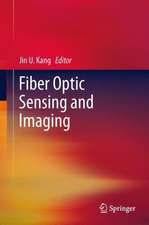Surface Acoustic Wave Devices in Telecommunications: Modelling and Simulation
Autor Ken-Ya Hashimotoen Limba Engleză Hardback – 20 iun 2000
| Toate formatele și edițiile | Preț | Express |
|---|---|---|
| Paperback (1) | 946.87 lei 43-57 zile | |
| Springer Berlin, Heidelberg – 30 noi 2010 | 946.87 lei 43-57 zile | |
| Hardback (1) | 949.90 lei 43-57 zile | |
| Springer Berlin, Heidelberg – 20 iun 2000 | 949.90 lei 43-57 zile |
Preț: 949.90 lei
Preț vechi: 1158.41 lei
-18% Nou
Puncte Express: 1425
Preț estimativ în valută:
181.82€ • 197.56$ • 152.83£
181.82€ • 197.56$ • 152.83£
Carte tipărită la comandă
Livrare economică 21 aprilie-05 mai
Preluare comenzi: 021 569.72.76
Specificații
ISBN-13: 9783540672326
ISBN-10: 354067232X
Pagini: 352
Ilustrații: XIII, 330 p.
Dimensiuni: 156 x 234 x 25 mm
Greutate: 0.57 kg
Ediția:2000
Editura: Springer Berlin, Heidelberg
Colecția Springer
Locul publicării:Berlin, Heidelberg, Germany
ISBN-10: 354067232X
Pagini: 352
Ilustrații: XIII, 330 p.
Dimensiuni: 156 x 234 x 25 mm
Greutate: 0.57 kg
Ediția:2000
Editura: Springer Berlin, Heidelberg
Colecția Springer
Locul publicării:Berlin, Heidelberg, Germany
Public țintă
ResearchDescriere
Although the existence of the surface acoustic wave (SAW) was first dis cussed in 1885 by Lord Rayleigh [1], it did not receive engineering interest for a long time. In 1965, the situation changed dramatically. White suggested that SAWs can be excited and detected efficiently by using an interdigital transducer (IDT) placed on a piezoelectric substrate [2]. This is because very fine IDTs can be mass-produced by using photolithography, which has been well developed for semiconductor device fabrication, and proper design of the IDT enables the construction of transversal filters with outstanding perfor mance. Then, in Europe and America, a vast amount of effort was invested in the research and development of SAW devices for military and communication uses, such as delay lines and pulse compression filters for radar and highly stable resonators for clock generation. Research activities are reflected in the various technical papers represented by special issues [3-5] and proceedings [6]. The establishment of design and fabrication technologies and the rapid growth of digital technologies, represented by the microcomputer, meant that the importance of SAW devices for the military decreased year by year and most researchers in national institutions and universities left this field after reductions or cuts in their financial support. Then the end of the Cold War forced many SAW researchers in companies to do so, too.
Cuprins
1. Bulk Acoustic and Surface Acoustic Waves.- 2. Grating.- 3. Interdigital Transducers.- 4. Transversal Filters.- 5. Resonators.- 6. Selection of Substrate Material.- 7. Coupling-of-Modes Theory.- 8. Simulation of SH-type SAW Devices.- A. Physics of Acoustic Waves.- A.1 Elasticity of Solids.- A.2 Piezoelectricity.- A.3 Surface Acoustic Waves.- A.4 Effective Acoustic Admittance Matrix and Permittivity.- A.5 Acoustic Wave Properties in 6mm Materials.- A.5.1 Rayleigh-Type SAWs.- A.5.2 Effective Permittivity for BGS Waves.- A.5.3 Effective Acoustic Admittance Matrix.- A.6 Wave Excitation.- A.6.1 Integration Path.- A.6.2 Electrostatic Coupling.- A.6.3 BGS Wave Excitation.- A.6.4 SSBW Excitation.- References.- B. Analysis of Wave Propagation on Grating Structures.- B.1 Summary.- B.2 Metallic Gratings.- B.2.1 Bløtekjr’s Theory for Single-Electrode Gratings.- B.2.2 Wagner’s Theory for Oblique Propagation.- B.2.3 Aoki’s Theory for Double-Electrode Gratings.- B.2.4 Extension to Triple-Electrode Gratings.- B.3 Analysis of Metallic Gratings with Finite Thickness.- B.3.1 Combination with Finite Element Method.- B.3.2 Application to Extended Bløtekjær Theories.- B.4 Wave Excitation and Propagation in Grating Structures.- B.4.1 Effective Permittivity for Grating Structures.- B.4.2 Evaluation of Discrete Green Function.- B.4.3 Delta-Function Model.- B.4.4 Infinite IDTs.- References.
Caracteristici
SAW devices are widely used in mobile communications, a still growing market
Gives an overview on the latest SAW technologies
Emphasis is on design and simulation of devices
Difficult mathematics is avoided
Author is the world leading expert in Modeling&Simulation of these devices
Includes supplementary material: sn.pub/extras
Gives an overview on the latest SAW technologies
Emphasis is on design and simulation of devices
Difficult mathematics is avoided
Author is the world leading expert in Modeling&Simulation of these devices
Includes supplementary material: sn.pub/extras















